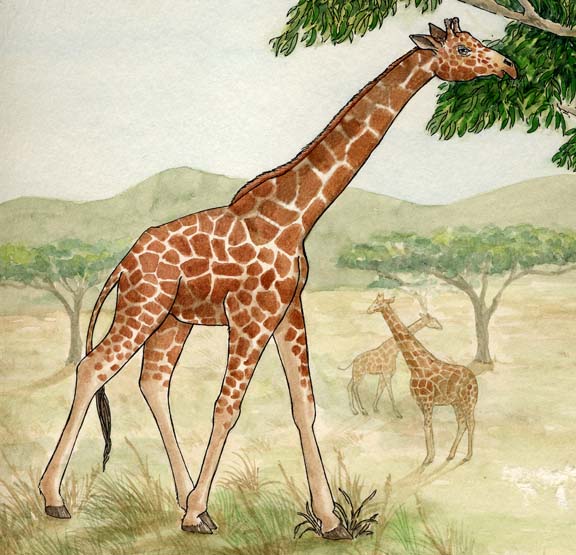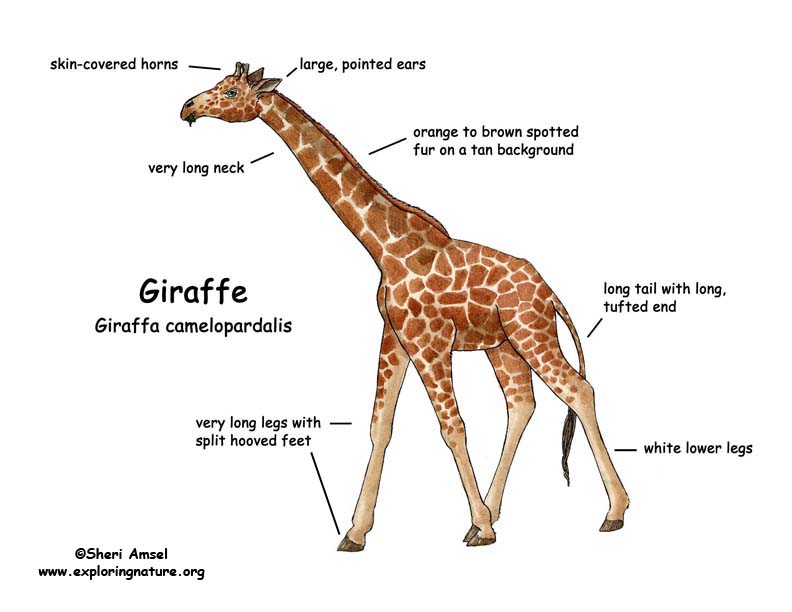

Giraffes live in Africa in a narrow band across the center of the continent and in small sections of South Africa.
Giraffes live on dry, tree spotted savannahs.
They are the tallest animal in the world, males reaching 15 feet or more and can weigh as much as 2,800 pounds. They are known for their brown-patched pattern, which is different on every giraffe. They have skin-covered horns. They have the same number of neck bone (cervical vertebrae) as humans —seven, but they are much longer! Each neck vertebra is about 8 inches long. The giraffe's face is covered by tough skin and fur that resist the sharp spines of the acacia tree.
Giraffes have a four-compartment stomach, like a cow. The first compartment ferments their tough, leafy food. Then they bring it back up and re-chew it. This is called "chewing their cud", a trait of "ruminants (named after one of their stomach compartments -- the rumen)." Once the food is fermented and re-chewed, it is ready to be digested in the later stomach compartments.
Different subspecies of giraffe have different sized and shaped spots. There may be as many as nine subspecies of giraffe in Africa, though they do interbreed where their range overlaps.
They can run fast — up to 35 mph when they feel threatened, though can not maintain top speed for long. Because of their very long legs though, even walking, giraffes can cover 10 mph.
Giraffes live in family groups with only one full grown male (bull), many females, calves and young males. Adult males live alone or in pairs and only join the group to mate. Male giraffe will spar for dominance by knocking their heads into another male. This is called "neck knocking". The strongest male will get to choose the females and food of his choice.
When giraffes approach a watering hole to drink, the group takes turns, watching for danger while one animal drinks at a time. Because of their height, a giraffe must bend their forelegs way down to get low enough to drink, which makes them vulnerable to attack by predators, so the group protection is important. They also never all lie down at the same time to rest for the same reason, but take turns while other keep watch.
Giraffes eat leaves (browsers), their long necks reaching where shorter leaf eaters cannot go. Their 18-inch-long tongues and prehensile upper lip can quickly strip leaves from branches (prehensile means it can grasp like fingers). They especially like the leaves of the acacia tree. An adult giraffe can eat more than 50 pounds of leaves every day. They spend many hours every day eating – usually in the early morning and late evening hours. Eating at these times has the added benefit of including dew on the leaves, which decreases their need for water.
Predators include lions and leopards.
Females are pregnant for about 15 months (gestation), having one calf. Newborns are over six feet tall and can weigh up to 150 pounds. They stand within minutes to nurse, but lay down in the tall grass to hide from perdators while their mother feed. Like a newborn fawn, giraffe young have little scent, so can lay still in the grass without being "sniffed out" by predators. Even so, half the newborn giraffes do not survive to grow up because of predation. Within just a couple of weeks they begin to eat leaves, but they keep nursing for their first year until they are old enough to drink from the watering hole safely.
They live about 25 years in the wild. They are listed as Lower Risk - conservation dependent, though some subspecies are getting rarer every year.
Kingdom: Animalia
Phylum: Chordata
Subphylum: Vertebrata
Class: Mammalia
Order: Artiodactyla
Family: Giraffidae
Genus: Giraffa
Species: Giraffa camelopardalis
When you research information you must cite the reference. Citing for websites is different from citing from books, magazines and periodicals. The style of citing shown here is from the MLA Style Citations (Modern Language Association).
When citing a WEBSITE the general format is as follows.
Author Last Name, First Name(s). "Title: Subtitle of Part of Web Page, if appropriate." Title: Subtitle: Section of Page if appropriate. Sponsoring/Publishing Agency, If Given. Additional significant descriptive information. Date of Electronic Publication or other Date, such as Last Updated. Day Month Year of access < URL >.
Amsel, Sheri. "Giraffe" Exploring Nature Educational Resource ©2005-2024. December 13, 2024
< http://www.exploringnature.org/db/view/Giraffe >

